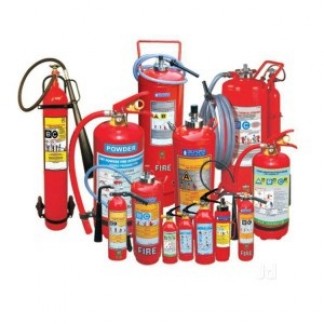
Rs. 550.00/Onwords
( Price inclusive of all taxes )
Availability: In stock
| ABC-6 kg | Rs.1200/- |
| ABC-2 kg | Rs.585/- |
| ABC-1kg | Rs.550/- |
| CO2-4.5kg | Rs.3800/- |
Fire is a rapid chemical reaction of oxidant with fuel accompanied by the release of energy, indicated by incandescence or flame.
For a fire to happen, the following elements are essential • • Oxidiser to sustain combustion. • Heat to reach ignition temperature. • Fuel or combustible material. This results in a chemical chain reaction which starts a fire. Removing any of these elements will extinguish the fire.
During a fire heat transfer occurs by • Conduction - transfer of heat within the material itself. • Convection - transfer of heat by the physical movement of hot masses of air. • Radiation - refers to the emission of heat in the form of electromagnetic waves.
Ignition can occur by • Electrically powered equipment- Arcing, damaged wiring, over heating of cables due to excess loads, loose electrical connections, heat from electric bulbs etc. • Open flame • Hot surfaces • Sparks from welding operations • Chemical reaction between incompatible chemicals • Smoking • Batteries
In a flammable liquid fire, it is the vapours released from the surface of the liquid that burns. Flash point is the lowest temperature at which a liquid produces enough vapor to form an ignitable mixture. E.g., Diethyl ether (-45 O C) Methyl alcohol (11.1 O C) Lower the flash point of a flammable liquid, greater the hazard.
Class A Fires — solid combustible materials of organic nature such as wood, paper, rubber, plastics, etc.
Class B Fires — flammable liquids
Class C Fires — flammable gases under pressure including liquefied gases.
Class D Fires — combustible metals, such as magnesium, sodium, potassium, etc,
Type of extinguishers and the classes of fire for which they can be used Water Class A fire Dry chemical powder Class B & C fire Foam Class A & B fire Carbon dioxide Class B & C fire Special dry powder Class D fire
Water Extinguisher -
• They are used for Class A fires. • Water removes heat and extinguish the fire. • Water must not be used on fires involving live electrical equipment as it can cause electrocution. • Water must not be used on metal fires.
Carbon Dioxide Extinguisher -
• CO2 extinguishers are mainly used for Class B and C fires. • CO2 extinguish the fire by displacing oxygen in the surrounding air.
CO2 is not suitable for fires involving metals. • It’s principal advantage is that it does not leave any residue. • Can be used on electrical/electronic equipment.
Foam Type Extinguishers -
The extinguishing agent is aqueous film forming concentrate in water which forms air foams when discharged through an aspirating nozzle. • It has a blanketing effect excluding oxygen from the surface of the fuel as it spreads on the fuel. • Prevents vapour formation from the surface of the burning liquid.
• It develops a floating aqueous film of solution under the foam on fuel surface and cool the burning surface. • AFF extinguishers must not be used on electrical and metal fires.
Dry Chemical Powder(DCP) Extinguisher-
• The main base chemicals used in DCP extinguishers are sodium bicarbonate and potassium bicarbonate. • DCP extinguishers puts out fire by coating the fuel surface with chemical powder. • This separates the fuel from the oxygen in the air and prevent vapor formation.
• The powder also interrupts the chemical chain reaction of fire. • The disadvantage is that it leaves residue particularly making it difficult to clean up in case of sensitive equipment.